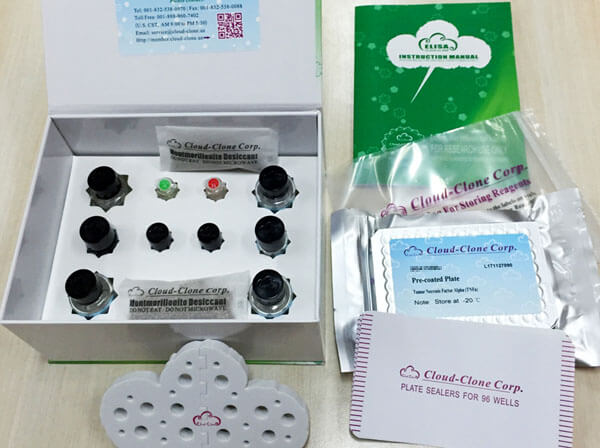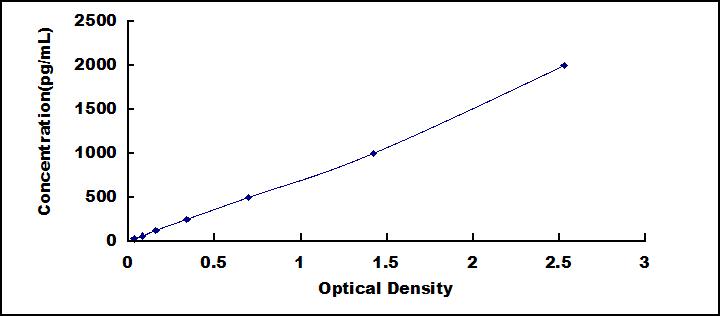ELISA Kit for Angiopoietin 1 (ANGPT1) 

ANG1; AGP1; AGPT; ANG-I
- UOM
- FOB US$ 479.00 US$ 684.00 US$ 3,078.00 US$ 5,814.00 US$ 47,880.00
- Quantity
Overview
Properties
- Product No.SEA008Ra
- Organism SpeciesRattus norvegicus (Rat) Same name, Different species.
- ApplicationsEnzyme-linked immunosorbent assay for Antigen Detection.
Research use only - DownloadInstruction Manual
- CategoryTumor immunityCardiovascular biology
Sign into your account
Share a new citation as an author
Upload your experimental result
Review

Contact us
Please fill in the blank.
Recovery
Matrices listed below were spiked with certain level of recombinant Angiopoietin 1 (ANGPT1) and the recovery rates were calculated by comparing the measured value to the expected amount of Angiopoietin 1 (ANGPT1) in samples.
| Matrix | Recovery range (%) | Average(%) |
| serum(n=5) | 83-93 | 88 |
| EDTA plasma(n=5) | 80-93 | 89 |
| heparin plasma(n=5) | 79-102 | 94 |
Precision
Intra-assay Precision (Precision within an assay): 3 samples with low, middle and high level Angiopoietin 1 (ANGPT1) were tested 20 times on one plate, respectively.
Inter-assay Precision (Precision between assays): 3 samples with low, middle and high level Angiopoietin 1 (ANGPT1) were tested on 3 different plates, 8 replicates in each plate.
CV(%) = SD/meanX100
Intra-Assay: CV<10%
Inter-Assay: CV<12%
Linearity
The linearity of the kit was assayed by testing samples spiked with appropriate concentration of Angiopoietin 1 (ANGPT1) and their serial dilutions. The results were demonstrated by the percentage of calculated concentration to the expected.
| Sample | 1:2 | 1:4 | 1:8 | 1:16 |
| serum(n=5) | 86-94% | 86-99% | 83-90% | 81-91% |
| EDTA plasma(n=5) | 97-105% | 78-90% | 79-101% | 83-97% |
| heparin plasma(n=5) | 89-99% | 83-97% | 87-94% | 82-93% |
Stability
The stability of kit is determined by the loss rate of activity. The loss rate of this kit is less than 5% within the expiration date under appropriate storage condition.
To minimize extra influence on the performance, operation procedures and lab conditions, especially room temperature, air humidity, incubator temperature should be strictly controlled. It is also strongly suggested that the whole assay is performed by the same operator from the beginning to the end.
Reagents and materials provided
| Reagents | Quantity | Reagents | Quantity |
| Pre-coated, ready to use 96-well strip plate | 1 | Plate sealer for 96 wells | 4 |
| Standard | 2 | Standard Diluent | 1×20mL |
| Detection Reagent A | 1×120µL | Assay Diluent A | 1×12mL |
| Detection Reagent B | 1×120µL | Assay Diluent B | 1×12mL |
| TMB Substrate | 1×9mL | Stop Solution | 1×6mL |
| Wash Buffer (30 × concentrate) | 1×20mL | Instruction manual | 1 |
Assay procedure summary
1. Prepare all reagents, samples and standards;
2. Add 100µL standard or sample to each well. Incubate 1 hours at 37°C;
3. Aspirate and add 100µL prepared Detection Reagent A. Incubate 1 hour at 37°C;
4. Aspirate and wash 3 times;
5. Add 100µL prepared Detection Reagent B. Incubate 30 minutes at 37°C;
6. Aspirate and wash 5 times;
7. Add 90µL Substrate Solution. Incubate 10-20 minutes at 37°C;
8. Add 50µL Stop Solution. Read at 450nm immediately.

Test principle
The test principle applied in this kit is Sandwich enzyme immunoassay. The microtiter plate provided in this kit has been pre-coated with an antibody specific to Angiopoietin 1 (ANGPT1). Standards or samples are then added to the appropriate microtiter plate wells with a biotin-conjugated antibody specific to Angiopoietin 1 (ANGPT1). Next, Avidin conjugated to Horseradish Peroxidase (HRP) is added to each microplate well and incubated. After TMB substrate solution is added, only those wells that contain Angiopoietin 1 (ANGPT1), biotin-conjugated antibody and enzyme-conjugated Avidin will exhibit a change in color. The enzyme-substrate reaction is terminated by the addition of sulphuric acid solution and the color change is measured spectrophotometrically at a wavelength of 450nm ± 10nm. The concentration of Angiopoietin 1 (ANGPT1) in the samples is then determined by comparing the O.D. of the samples to the standard curve.
Giveaways
Increment services
-
 Single-component Reagents of Assay Kit
Single-component Reagents of Assay Kit
-
 Lysis Buffer Specific for ELISA / CLIA
Lysis Buffer Specific for ELISA / CLIA
-
 Quality Control of Kit
Quality Control of Kit
-
 ELISA Kit Customized Service
ELISA Kit Customized Service
-
 Disease Model Customized Service
Disease Model Customized Service
-
 Serums Customized Service
Serums Customized Service
-
 TGFB1 Activation Reagent
TGFB1 Activation Reagent
-
 Real Time PCR Experimental Service
Real Time PCR Experimental Service
-
 Streptavidin
Streptavidin
-
 Fast blue Protein Stain solution
Fast blue Protein Stain solution
-
 Single-component Reagents of FLIA Kit
Single-component Reagents of FLIA Kit
-
 Streptavidin-Agarose Beads
Streptavidin-Agarose Beads
Citations
- Evaluation of Changes in Doppler Ultrasonography Indices and Levels of Maternal Serum Angiogenic Factors throughout Pregnancy in EwesScience: Article
- High Mobility Group Box 1 Promotes Angiogenesis from Bone Marrow-derived Endothelial Progenitor Cells after Myocardial InfarctionPubMed: 25735431
- Diabetes-induced renal failure is associated with tissue inflammation and neutrophil gelatinase-associated lipocalin: Effects of resveratrolpublication:299492265_Diabetes-induced_renal_failu
- Angiopoietin-1 facilitates recovery of hematopoiesis in radiated micePubmed:27347310
- Increased plasma concentrations of interleukin 35 in patients with coronary artery diseaseJournal:-19
- A new angiogenesis prognostic index with VEGFA, PlGF, and angiopoietin 1 predicts survival in patients with advanced gastric cancerpubmed:28425270
- Flunarizine suppresses endothelial Angiopoietin-2 in a calcium - dependent fashion in sepsis.pubmed:28276491
- The ratio of serum Angiopoietin-1 to Angiopoietin-2 in patients with cervical cancer is a valuable diagnostic and prognostic biomarkerpubmed:28584715
- Prediction of Response to Sorafenib in Hepatocellular Carcinoma: A Marker Panel by Multiple Reaction Monitoring-Mass Spectrometrypubmed:28550167
- Cervical cancer cell–derived angiopoietins promote tumor progressionpubmed:28720059
- RHEUMATOID ARTHRITIS RELATED BIOMARKER20170350884
- Vasculotide, an angiopoietin-1 mimetic, restores microcirculatory perfusion and microvascular leakage and decreases fluid resuscitation requirements in …Pubmed:28968277
- Vasculotide, an angiopoietin-1 mimetic, reduces pulmonary vascular leakage and preserves microcirculatory perfusion during cardiopulmonary bypass in rats10.1016:j.bja.2018.05.049
- Toll-like receptor 2 deficiency hyperactivates the FoxO1 transcription factor and induces aging-associated cardiac dysfunction in micePubmed:29929978
- Clinical Significance of Nectin-4 Expression in Metastasis and Angiogenesis for Tumor RelapseDoi: 10.4143/crt.2018.214
- Prostaglandin-mediated effects in early canine corpus luteum: In vivo effects on vascular and immune factorsPubmed: 30929911
- Association between Upper-airway Surgery and Ameliorative Risk Markers of endothelial function in obstructive Sleep ApneaPubmed: 31882827
- Effects of interleukin-6 and tumor necrosis factor-α on the expression of angiogenic and collagenolytic factors in premature and mature adipocytesPubmed: 32800538
- Effects of protein malnutrition on haematopoietic regulatory activity of bone marrow mesenchymal stem cells33705953
- The effect of targeting Tie2 on hemorrhagic shock-induced renal perfusion disturbances in rats33997943
- Potential of thrombospondin-1 in treatment of polycystic ovary syndrome rat model: a preliminary study34282706
- RAR-Related Orphan Receptor: An Accelerated Preeclampsia Progression by Activating the JAK/STAT3 PathwayPubmed:35619579








